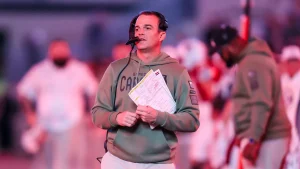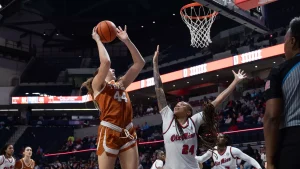
Since joining the Indiana Fever, Caitlin Clark has noticed significant shifts in the team’s attitude.
Caitlin Clark, a standout player in women’s college basketball, made waves during her career at the University of Iowa. Known for her incredible scoring ability, court vision, and leadership, Clark quickly became one of the most recognizable names in the sport. After an illustrious college career, her transition to the WNBA, particularly with the Indiana Fever, has been a focal point for both the league and its fans.
The transition from college basketball to professional basketball is always a monumental shift for any player, and Caitlin Clark is no exception. Upon joining the Indiana Fever, she noticed not only a shift in the caliber of competition but also a noticeable change in the team’s culture and overall attitude. This adjustment period is crucial for a young star like Clark, who has been accustomed to leading teams to victory and now has to adapt to a new environment and set of expectations.
The Transition to the WNBA
Clark’s arrival in the WNBA with the Indiana Fever marked the beginning of a new chapter in her career. While the WNBA is an established league with some of the best basketball talent in the world, it still has its own unique dynamics compared to college sports. In college, the spotlight often shines brightest on individual players, and teams rely heavily on star power to push them through games. However, in the WNBA, the competition is intense, and no team can solely depend on one player, no matter how talented they are.
In this environment, Caitlin Clark quickly realized that her teammates’ attitudes toward the game, their approach to practice, and the team’s overall strategy had evolved. At Iowa, Clark was used to a fast-paced style of play that was built around her strengths—her ability to shoot from deep range, make quick decisions, and lead the offense. In the WNBA, she now faces players who are equally as skilled, experienced, and capable of contributing to the game on both ends of the court.
What became evident to Clark early on was that the Fever, historically a team that had struggled to find consistency, were in the midst of a cultural shift. The organization was looking for a new identity, and Clark, with her high-profile background, was seen as a catalyst for change. This shift, however, wasn’t just about the playbook or the roster changes—it was about instilling a new mindset and attitude in both the players and the fans.
The Shift in Team Attitude
Clark noticed that joining the Indiana Fever meant entering a space where rebuilding was a key theme. The team had undergone significant roster changes and had embraced a fresh approach to developing players. While the Fever had a rich history, it was clear that they were focused on creating a new culture—a culture that could eventually lead them back to contention in the WNBA. This meant not just looking for new talent but also revamping the mindset of the team to ensure everyone was on the same page.
From Clark’s perspective, this meant an environment where the emphasis was not solely on individual performances, but on collective growth. The Fever coaching staff, led by head coach, encouraged a mentality of resilience and teamwork, prioritizing effort and communication over pure individual accolades. In college, Caitlin Clark often found herself carrying the weight of her team’s success on her shoulders, but in the WNBA, the atmosphere at the Fever pushed for a balanced approach where every player contributed to the team’s collective success.
The Fever’s players, many of whom had been with the organization for several years, were also adjusting to the new philosophy. For players who had previously been accustomed to a different style of leadership and team dynamics, Clark’s arrival served as a reminder of what a change in mentality could mean for the team. Her work ethic, leadership, and competitive spirit became contagious, influencing her teammates to embrace a similar approach. The Fever’s attitude towards preparation, practice, and game execution began to shift, with a stronger emphasis on intensity and consistency.
Leadership and Trust
Caitlin Clark has always been a natural leader, but her leadership style in the WNBA had to evolve. At Iowa, she was the clear leader and focal point, but with the Fever, she joined a team with several experienced players. This required her to adjust her leadership approach. Rather than stepping in as the sole leader, Clark had to find a balance where she could contribute her immense talent while building trust with her teammates. In a professional setting, leadership is often more about empowerment and collaboration, and Clark quickly learned that her leadership could be best utilized through fostering trust and cohesion within the team.
One of the biggest challenges Clark faced was learning to trust her teammates in ways that she hadn’t before. In college, she was often the player with the ball in her hands at the most critical moments, but in the WNBA, she could no longer afford to shoulder all of that responsibility herself. The Fever’s new emphasis on teamwork and collective effort required Clark to evolve her game and develop a greater level of trust in her teammates’ abilities. In doing so, the Fever’s attitude shifted from a sense of reliance on one star player to a mentality that success comes from collective effort and mutual support.
The leadership of the Fever’s coaching staff also played a crucial role in shaping this shift. Coach and the rest of the team staff emphasized player development, which meant that every player on the roster had to buy into the philosophy of constant improvement. For Clark, this was an exciting and empowering environment, one where growth and learning were key components of the team’s identity.
The Role of Veteran Players
Veteran players on the Fever, many of whom had seen their fair share of ups and downs with the franchise, played a critical role in the cultural transformation. While Clark brought a fresh, young energy to the team, the veterans were the ones who helped lay the foundation for success, both on and off the court. They shared their knowledge of the league, helped instill a sense of professionalism, and guided Clark through the nuances of professional basketball.
The presence of veteran players allowed Clark to acclimate to the WNBA’s level of competition. Having been accustomed to being the leader on the court, Clark now had to adjust to the fact that there were multiple players with similar skills, and even more importantly, years of professional experience. The veterans helped Clark understand the importance of patience, discipline, and preparation, which were necessary elements to succeed at the highest level. These relationships also played a part in molding the team’s attitude, shifting it from one of individual achievement to a more unified approach.
Building Confidence
One of the noticeable shifts in the Fever’s attitude since Clark’s arrival has been the growth in the confidence of not just Clark herself, but also her teammates. The confidence that Clark brought with her to the team became contagious. Her ability to step into big moments with composure and make clutch plays sent a message to the entire roster that they, too, could rise to the occasion.
For a team like the Indiana Fever, who had faced struggles in recent seasons, this newfound confidence was invaluable. The players began to understand that they didn’t have to rely solely on individual heroics to win games. Instead, they trusted that their teammates could step up, just as Clark often did. The culture around the Fever began to shift from a team that was trying to survive in a competitive league to a team that believed they could thrive and make a run toward the playoffs.
The Impact on the Fanbase
Perhaps one of the most significant shifts that Caitlin Clark brought to the Indiana Fever was the renewed energy she helped generate among the fanbase. Clark’s arrival added a fresh level of excitement, both for the franchise and for fans who had been waiting for a return to relevance. Fans were eager to see how a player of Clark’s caliber would influence the Fever’s fortunes, and they were not disappointed. Her dynamic style of play and fiery competitiveness helped rejuvenate the fanbase, and as a result, the team received an influx of support and attention.
The Fever’s fanbase, which had been relatively quiet during the team’s down years, now found a renewed sense of hope and excitement. With Clark leading the charge, there was an undeniable sense that the team was on the verge of a rebirth. This shift in fan attitude further mirrored the team’s cultural transformation, as the players and fans alike started to embrace the idea that the Fever were no longer just a team trying to make it through the season—they were a team that could compete at the highest levels and eventually contend for a championship.
Joining the Indiana Fever marked a pivotal moment for Caitlin Clark in her basketball career. It was a transition from the bright lights of college basketball to the high-pressure environment of the WNBA. The shift in the team’s attitude that Clark experienced has been profound, and she has played a significant role in driving that change. Through her leadership, work ethic, and ability to inspire her teammates, Clark has helped to instill a new mindset in the Fever, one that emphasizes teamwork, resilience, and confidence.
While the team still has a long way to go in terms of achieving sustained success, the transformation in their culture since Clark’s arrival is undeniable. The Fever have embraced a new philosophy of collective growth and belief in one another, and Caitlin Clark’s presence has been a catalyst in driving that change.





